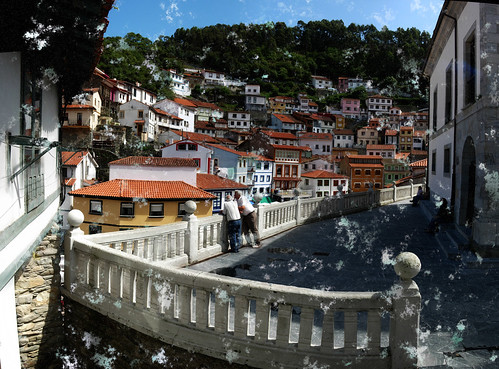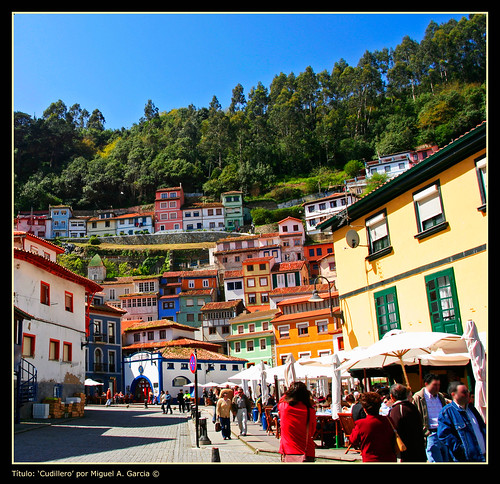
Cudillero councils, Valdes, Tineo, Allande and make the Shire Chambers Vaqueira. Valdes Cudillero and give away the visitor beaches and cliffs that impress the eye, while Tineo takes pride in its noble past and mining of an imposing gastronomy captained by chosco is joy for the palate. Allande megalithic monuments and forts houses. In Sales, as the whole area, are present reminiscences of vaqueiros, cattle nomads.
Route description.
Since we take the local road Cudillero towards El Pito, and later the N-632. Continue until San Martin de Luiña (left turn on the AS-222) and Soto Luiña. From this location we Cabo Vidio within 10 minutes after turn right. We return to the N-632 which leads to Ballota, Cadavedo, Villademoros (right turn) and Luarca.
A 17 km de Luarca, the AS-219, we find Aristébano, Navelgas and Barcena, from where we take the AS-218. In Obon, the AS-217, we Rozadiella and continue until it joins the AS-15 to reach the Allande Pola, where we will take the AS-14 to San Emiliano and on the way, we can divert the AS – 34 Into Valledor. In return, we will again in the AS-15 Pola and we can see, on several deviations to the right and Celon Beduledo. Continuing along that same road, we Tineo following link to the AS-214.
Since we will again Tineo AS-215 and connects with the AS-214 until you reach the AS-15 that leads to Santianes and Tuna (offset by the AS-310). We follow the AS-15 to take AS-226 that leads to Chambers, where the route ends.
Path
Cudillero – El Pito – San Martin de Luiña – Luiña Soto – Cabo Vidio – Ballota – Cadavedo – Villademoros – Luarca – Aristébano – Navelgas – Bárcena – Obon – Rozadiella – Pola de Allande – San Emiliano – Valledor – Beduledo – Celona – Tineo — Santianes – Tuna – Chambers
Cudillero started the route, people facing the sea which is characterized by its location in an amphitheater on the coast. The port must-visit in the Asturian coast, the parish church of San Pedro (s. XVI), the chapel of Santo Cristo Humilladero the auction, the viewpoint over the old port and the Fountain of Song are emblematic inhabitants The Pixueto.

Nearby is El Pito, we find the family mansion Selgas, Selgas headquarters of the foundation, and a little later in Luiña Soto is interesting to the rectory, now restored and old pilgrim’s hospital in the pilgrimage route along the coast. The next stop we will do in Cabo Vidio, near Oviñana, where the views are breathtaking Asturian coast.
The council Cudillero with magnificent beaches, many of them difficult to access. The Shell Artedo, San Pedro or El Silencio are some of the best known.
On the way to Luarca, Valdes capital of the council, we find many houses and palaces Indians. Specific examples we can see in the towns of Ballota and Cadavedo. In Villademoros stresses the military tower Middle Ages.
Valdés live in beautiful beaches and coves, as Esva River, with the interior valleys and mountains further south. Luarca, located on the Black River, is a traditional fishing village and whaling. Sailors neighborhoods are typical of the Fish and Cambaral, the latter is the Bureau of mariners. A magnificent view of the set is visible from the chapel of San Roque. The harbor is possible to visit the palace of the Marquis de Ferrera, the home of the Marquis of Gamoneda, with its monumental shield, the Town Hall in the plaza Alfonso X, and many examples of Indian architecture. Going to the lighthouse we visit the Atalaya, former whalers watchtower, where we find the chapel and cemetery, the latter one of the most beautiful and ancient of Asturias.
From Luarca continue by the council Tineo. Aristébano is a high interest in the route. We continue our journey towards Navelgas, where is located the Gold Museum of Asturias, where we can practice hitting the gold activity, then we Bárcena, with the monastery of San Miguel (s.Xlll), and Obon, where you can see the monastery of Santa María la Real. From here follow the route to Allande council.
In the town of Pola de Allande can visit on a hill, the palace of Cienfuegos and the parish church of San Andrés (s.XVl). But in addition, this council houses megalithic monuments and forts, such as San Chuis (in Beduledo) and numerous examples of religious architecture and stately, like the Romanesque church of Santa Maria de Celona (s.XVll and the tower of St. Martin de Valledor). It is worth closer to San Emiliano, a town designated as Joint Artistic and Picturesque.

The council of Tineo remembers his past finely emblazoned on many of their homes. Area also known for its rich cuisine and their hunting and fishing, yet retained the richness of its forests. In its rivers and streams is practiced for gold as they did in the era of the Celts and Romans: a trough. Located between the basins of the Narcea and Esva latter protected natural area. Tineo maintains the natural beauty of a well-kept environment.
In capital Tineo can visit the parish church of St. Peter (s. XIII), the stresses its thirteenth-century altarpiece, the mere palace, City Hall, the home of Tineo-Maldonado, the convent of San Francisco (s. XIII), or the Museum of Sacred Art.
Nearby we visited the house of Queipo in Santianes; Tuna, with several examples of manor houses (house of Cape River, home of the Tower, Palace Ferreira, Irrigation house, tower house Campomanes), and the palace and collegiate of Oman (s.XVll) in Rozadiella.
On Venues stands the Collegiate Church of Santa Maria Maggiore (s.XlV), where the mausoleum of the Inquisitor Valdés Salas and a magnificent seventeenth century altarpiece is worth going to San Martin Yew, declared a Natural Monument, and give you a taste the palate with sweet carajitos known as the teacher. Chambers also offers the possibility of many and varied routes; the Vaqueiros of the Peak Aguión or Salmon.
Good Travel!
Leave a Reply
You must be logged in to post a comment.
Recent Comments